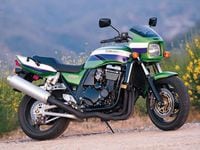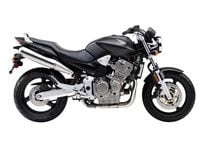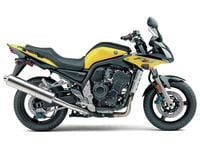Kawasaki has never been shy about touting its racing successes, and one of its earliest homages to its on-track prowess was the ZRX1100/1200, a modernized tribute to the bike that carried Eddie Lawson to the AMA Superbike Championship in 1981 and '82. Although old-school—some might say hopelessly outdated—by today's standards, the burly and versatile ZRX makes up in versatility what it lacks in cutting-edge technology.
The beating heart of the ZRX is a liquid-cooled four-cylinder engine that displaced 1,052cc when it first came out and got a boost to 1,164cc in 2001. Based loosely on the ZX-11’s powerplant, the ZRX’s carbureted mill got a retune that punched up the midrange and gave it a broad, flat torque curve—more than 60 pound-feet at 3,000 rpm and peaking at 72 at 6,000 rpm. Peak horsepower was 97 at the rear wheel; it’s not much these days considering the displacement, but it’s adequate just about any day for seat-clenching acceleration. The displacement bump in ’01 upped those figures to 113 hp and 80 pound-feet of torque.
The ZRX’s chassis—steel-tube frame, twin shocks, and an elaborately braced swingarm—has “retro” written all over it. Up front a pair of 310mm rotors paired with six-piston calipers brings the 544-pound ZRX to a halt, while at the other end a single 250mm rotor with a single-piston caliper does its best to help. Both the 1100 and the 1200 roll on 17-inch wheels shod with 120/70 tires up front; the 1100’s 170/60 rear was upgraded to a 180/55 for the 1200.
For a race-inspired bike, the ZRX’s seating position is friendly—no prostrate-yourself-before-the-god-of-speed crouch—but the tiny fairing does little to blunt the wind. A welcome touch of retro is the bolt-on tubular handlebar, which can be swapped out for a lower one. Handling, while far from 600-class quick, is predictable, and the feedback from the chassis inspires confidence. Not too much, though, because at a certain point you realize you’re on a large, heavy bike that’ll bite back if you twist its tail too hard.
Aftermarket shocks and a fork kit do wonders for suspension competence, and the eccentric drive-chain adjusters can be rotated 180 degrees for more ride height at the rear and quicker steering. The brakes are just okay; better pads and braided-steel lines make a big difference. The handsome stock exhaust ends up on the shelf more often than not, replaced by a lighter, louder one. Make sure the jetting has been adjusted and checked out on a dyno; the ZRX gets sulky if it’s not spot on.
Condition is an issue on any used bike but more so on the ZRX; without its signature look it’s still a nice big-bore standard, but so is a used 1200 Bandit, usually for less money. Try for a stock one that’s been garaged because the finish on some of the exterior parts—especially the engine—doesn’t always hold up well. A barn find or a bike that’s been living in a carport should be dragged out into the daylight and inspected closely. Finally, as any ZRX aficionado will tell you, the green ones are definitely the fastest.
Big ol’ brute of a scoot dressed up in ’80s Superbike chic. Good power and handling make the deal even sweeter.
A diet and a workout plan wouldn’t hurt. Often modified, not always well.
Dodgy aftermarket muffler, poor jetting, corroded surface finish.
A blast from the past that plays very well in the present. Fast Eddie would approve.
1999 / $3,005
2000 / $3,250
2001 / $3,635
2002 / $3,895
2003 / $4,195
2004 / $4,520
2005 / $4,915
A contemporary of the ZRX, Honda’s lithe if underpowered 919 proved that a previous-generation supersport engine in a basic chassis could be a fine deal. Light handling, plenty of midrange torque, and Honda quality mark the 919. So does backpack stench from the high-mounted exhaust and neck pain from the bike’s total lack of wind protection.
The last application of the vaunted air/oil-cooled GSX-R engine lives here, tuned for about 100 rear-wheel horsepower but a massively wide band of torque. Soggy suspension and brakes made the half-faired 1200S better suited to sport-touring duty than canyon strafing, which is totally fine with the typical Bandit owner.
High-tech suspension and a nearly full-power R1 engine in a steel-tube chassis doesn’t sound like the recipe for success, but the FZ1’s perfect combination of performance and sporting prowess allied to good weather protection and near-ideal, real-world ergonomics made Yamaha’s naked bike the overdog in the early 2000s.
















/cloudfront-us-east-1.images.arcpublishing.com/octane/KIX5O23D5NAIBGFXBN3327DKZU.jpg)
/cloudfront-us-east-1.images.arcpublishing.com/octane/7GJYDUIPXRGMTMQKN6ONYOLBOU.jpg)
/cloudfront-us-east-1.images.arcpublishing.com/octane/MUQLOVLL2ZDGFH25ILABNBXKTI.jpg)
/cloudfront-us-east-1.images.arcpublishing.com/octane/TNOU5DNE2BC57MFPMGN2EIDXAM.jpg)
/cloudfront-us-east-1.images.arcpublishing.com/octane/GTCXACQGJ5HAPDTGWUQKDEH44E.jpg)
/cloudfront-us-east-1.images.arcpublishing.com/octane/S35YGSEMEZB4BLTDJTSZPF4GLA.jpg)
/cloudfront-us-east-1.images.arcpublishing.com/octane/5UOT6HPX2JFMRJAX6EH45AR4MQ.jpg)
/cloudfront-us-east-1.images.arcpublishing.com/octane/OKWOJWAKP5EP3OACCRRWPCIX2Q.jpg)
/cloudfront-us-east-1.images.arcpublishing.com/octane/2WF3SCE3NFBQXLDNJM7KMXA45E.jpg)
/cloudfront-us-east-1.images.arcpublishing.com/octane/G4MG6OUCJNBSHIS2MVVOTPX65E.jpg)
/cloudfront-us-east-1.images.arcpublishing.com/octane/IIGGWFOTOJGB7DB6DGBXCCMTDY.jpg)
/cloudfront-us-east-1.images.arcpublishing.com/octane/QSTCM6AVEZA5JJBUXNIQ3DSOF4.jpg)
/cloudfront-us-east-1.images.arcpublishing.com/octane/U4I7G625B5DMLF2DVIJDFZVV6M.jpg)
/cloudfront-us-east-1.images.arcpublishing.com/octane/B6XD6LS6IVCQPIU6HXDJSM3FHY.jpg)
/cloudfront-us-east-1.images.arcpublishing.com/octane/ICL63FEDDRDTTMINYICCEYGMDA.jpg)
/cloudfront-us-east-1.images.arcpublishing.com/octane/FCGZHQXRBZFLBAPC5SDIQLVF4I.jpg)
/cloudfront-us-east-1.images.arcpublishing.com/octane/WNOB6LDOIFFHJKPSVIWDYUGOPM.jpg)

/cloudfront-us-east-1.images.arcpublishing.com/octane/X33NU3E525ECRHXLNUJN2FTRKI.jpg)
/cloudfront-us-east-1.images.arcpublishing.com/octane/6KKT5NNL2JAVBOXMZYS5ZO76YA.jpg)
/cloudfront-us-east-1.images.arcpublishing.com/octane/J5RKG5O455GMPGQRF2OG6LRT7A.jpg)
/cloudfront-us-east-1.images.arcpublishing.com/octane/GX2CIZKQVRH2TATDM26KFG2DAE.jpg)
/cloudfront-us-east-1.images.arcpublishing.com/octane/ZWIDYSAKQZHD5BHREMQILXJCGM.jpg)
/cloudfront-us-east-1.images.arcpublishing.com/octane/CYUHJZCTSJCH3MRAQEIKXK7SCQ.jpg)